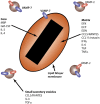Eosinophil cytokines, chemokines, and growth factors: emerging roles in immunity
- PMID: 25426119
- PMCID: PMC4225839
- DOI: 10.3389/fimmu.2014.00570
Eosinophil cytokines, chemokines, and growth factors: emerging roles in immunity
Abstract
Eosinophils derive from the bone marrow and circulate at low levels in the blood in healthy individuals. These granulated cells preferentially leave the circulation and marginate to tissues, where they are implicated in the regulation of innate and adaptive immunity. In diseases such as allergic inflammation, eosinophil numbers escalate markedly in the blood and tissues where inflammatory foci are located. Eosinophils possess a range of immunomodulatory factors that are released upon cell activation, including over 35 cytokines, growth factors, and chemokines. Unlike T and B cells, eosinophils can rapidly release cytokines within minutes in response to stimulation. While some cytokines are stored as pre-formed mediators in crystalloid granules and secretory vesicles, eosinophils are also capable of undergoing de novo synthesis and secretion of these immunological factors. Some of the molecular mechanisms that coordinate the final steps of cytokine secretion are hypothesized to involve binding of membrane fusion complexes comprised of soluble N-ethylmaleimide sensitive factor attachment protein receptors (SNAREs). These intracellular receptors regulate the release of granules and vesicles containing a range of secreted proteins, among which are cytokines and chemokines. Emerging evidence from both human and animal model-based research has suggested an active participation of eosinophils in several physiological/pathological processes such as immunomodulation and tissue remodeling. The observed eosinophil effector functions in health and disease implicate eosinophil cytokine secretion as a fundamental immunoregulatory process. The focus of this review is to describe the cytokines, growth factors, and chemokines that are elaborated by eosinophils, and to illustrate some of the intracellular events leading to the release of eosinophil-derived cytokines.
Keywords: allergy; asthma; cancer; chemokines; growth factors; helminths; inflammation.
Figures


References
Publication types
LinkOut - more resources
Full Text Sources
Other Literature Sources

